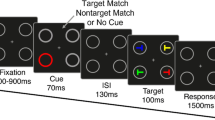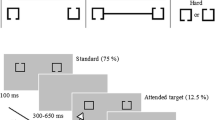Abstract
The present study used event-related potentials (ERPs) to explore the nature of shifts of spatial attention induced by object words with spatial associations. Specifically, we presented participants with cue words that denote objects that typically appear in high or low places (e.g., “moon,” “mouse”) at the center of the screen. After the presentation of the cue words, participants were asked to identify a target letter (“p” or “q”) at the top or bottom of the screen. Although the cues did not predict target locations (50 % valid) and were irrelevant to the task, the ERP analysis showed larger N1 amplitudes for congruent trials (i.e., the target letter’s location was congruent with the typical location of the word’s referent) and larger P3 amplitudes for incongruent trials. The present study extended previous studies by showing that the perception of object words could affect the processing of subsequent spatial stimuli at multiple stages (i.e., sensory processing and higher-level cognitive processing).




Similar content being viewed by others
References
Ansorge U, Wühr P (2004) A response-discrimination account of the Simon effect. J Exp Psychol Hum Percept Perform 30:365–377
Barsalou LW (2008) Grounded cognition. Annu Rev Psychol 59:617–645
Borghi AM, Glenberg AM, Kaschak MP (2004) Putting words in perspective. Mem Cogn 32:863–873
Correa Á, Lupiáñez J, Madrid E, Tudela P (2006) Temporal attention enhances early visual processing: a review and new evidence from event-related potentials. Brain Res 1076:116–128
Digiacomo MR, Marco-Pallarés J, Flores AB, Gómez CM (2008) Wavelet analysis of the EEG during the neurocognitive evaluation of invalidly cued targets. Brain Res 1234:94–103
Doallo S, Lorenzo-López L, Vizoso C, Rodríguez Holguín S, Amenedo E, Bará S, Cadaveira F (2005) Modulations of the visual N1 component of event-related potentials by central and peripheral cueing. Clin Neurophysiol 116:807–820
Dudschig C, Lachmair M, de la Vega I, De Filippis M, Kaup B (2012) From top to bottom: spatial shifts of attention caused by linguistic stimuli. Cogn Process 13:S151–S154
Estes Z, Verges M, Barsalou LW (2008) Head up, foot down: object words orient attention to the objects’ typical location. Psychol Sci 19:93–97
Gómez CM, Flores A (2011) A neurophysiological evaluation of a cognitive cycle in humans. Neurosci Biobehav Rev 35:452–461
Gómez CM, Flores A, Digiacomo MR, Ledesma A, González-Rosa J (2008) P3a and P3b components associated to the neurocognitive evaluation of invalidly cued targets. Neurosci Lett 430:181–185
Gozli DG, Chasteen AL, Pratt J (2012) The cost and benefit of implicit spatial cues for visual attention. J Exp Psychol Gen (advance online publication). doi:10.1037/a0030362
Griffin IC, Miniussi C, Nobre AC (2002) Multiple mechanisms of selective attention: differential modulation of stimulus processing by attention to space or time. Neuropsychologia 40:2325–2340
Hommel B, Müsseler J, Aschersleben G, Prinz W (2001) The theory of event coding (TEC): a framework for perception and action planning. Behav Brain Sci 24:849–937
Hopfinger JB, West VM (2006) Interactions between endogenous and exogenous attention on cortical visual processing. NeuroImage 31:774–789
Lachmair M, Dudschig C, De Filippis M, de la Vega I, Kaup B (2011) Root versus roof: automatic activation of location information during word processing. Psychon Bull Rev 18:1180–1188
Liu Y, Liang NY, Wang DJ, Zhang SY, Yang TY, Jie CY et al (1990) Dictionary of usage frequency of model Chinese words. China Astronautics Publishing House, Beijing
Mangun GR, Hillyard SA (1991) Modulations of sensory-evoked brain potentials indicate changes in perceptual processing during visual–spatial priming. J Exp Psychol Hum Percept Perform 17:1057–1074
Mansouri FA, Tanaka K, Buckley MJ (2009) Conflict-induced behavioural adjustment: a clue to the executive functions of the prefrontal cortex. Nat Rev Neurosci 10:141–152
Meier BP, Robinson MD (2004) Why the sunny side is up: associations between affect and vertical position. Psychol Sci 15:243–247
Neuhaus AH, Urbanek C, Opgen-Rhein C, Hahn E, Ta TMT, Koehler S, Gross M, Dettling M (2010) Event-related potentials associated with attention network test. Int J Psychophysiol 76:72–79
Ouellet M, Santiago J, Funes MJ, Lupiáñez J (2010) Thinking about the future moves attention to the right. J Exp Psychol Hum Percept Perform 36:17–24
Pecher D, Boot I (2011) Numbers in space: difference between concrete and abstract situations. Front Psychol 2:121. doi:10.3389/fpsyg.2011.00121
Polich J (2007) Updating P300: an integrative theory of P3a and P3b. Clin Neurophysiol 118:2128–2148
Ranzini M, Dehaene S, Piazza M, Hubbard EM (2009) Neural mechanisms of attentional shifts due to irrelevant spatial and numerical cues. Neuropsychologia 47:2615–2624
Salillas E, El Yagoubi R, Semenza C (2008) Sensory and cognitive processes of shifts of spatial attention induced by numbers: An ERP study. Cortex 44:406–413
Šetić M, Domijan D (2007) The influence of vertical spatial orientation on property verification. Lang Cogn Process 22:297–312
Silton RL, Heller W, Towers DN, Engels AS, Spielberg JM, Edgar JC, Sass SM et al (2010) The time course of activity in dorsolateral prefrontal cortex and anterior cingulate cortex during top-down attentional control. Neuroimage 50:1292–1302
Thornton T, Loetscher T, Yates MJ, Nicholls MER (2012) The highs and lows of the interaction between word meaning and space. J Exp Psychol Hum Percept Perform (advance online publication). doi:10.1037/a0030467
Wilson M (2002) Six views of embodied cognition. Psychon Bull Rev 9:625–636
Zanolie K, Van Dantzig S, Boot I, Wijnen J, Schubert TW, Giessner SR, Pecher D (2012) Mighty metaphors: behavioral and ERP evidence that power shifts attention on a vertical dimension. Brain Cogn 78:50–58
Zwaan RA, Yaxley RH (2003) Spatial iconicity affects semantic relatedness judgments. Psychon Bull Rev 10:954–958
Acknowledgments
The authors wish to thank 2 anonymous reviewers for their helpful comments. Additionally, this research was supported by the National Natural Science Foundation of China (31200768), the Key Discipline of Shanghai Normal University, and the Arts Project of Shanghai Normal University.
Author information
Authors and Affiliations
Corresponding authors
Appendix
Rights and permissions
About this article
Cite this article
Zhang, E., Luo, J., Zhang, J. et al. Neural mechanisms of shifts of spatial attention induced by object words with spatial associations: an ERP study. Exp Brain Res 227, 199–209 (2013). https://doi.org/10.1007/s00221-013-3500-x
Received:
Accepted:
Published:
Issue Date:
DOI: https://doi.org/10.1007/s00221-013-3500-x




